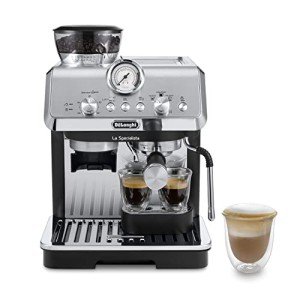This Is The Ugly Real Truth Of Italian Espresso Machines

Heat Exchange Espresso Machines: A Comprehensive Guide
Espresso machines have evolved considerably over the years, catering to the needs of home baristas and coffee specialists alike. Amongst these machines, heat exchange espresso machines have actually acquired appeal due to their ability to provide consistent performance and exceptional brew quality. In this article, we will check out the functions, benefits, and crucial features of heat exchange espresso machines, offering a thorough understanding for both prospective buyers and coffee enthusiasts.
Understanding Heat Exchange Technology
Heat exchange espresso machines run on a special concept that allows simultaneous water heating for brewing and steaming. They are geared up with a single boiler that utilizes a heat exchanger system. This feature is substantial as it allows users to brew espresso while steaming milk simultaneously, promoting efficiency in the coffee-making procedure.
How Does a Heat Exchange Espresso Machine Work?
The process starts with the machine's water inlet filling the boiler. As the water warms up, it turns to steam. The innovative heat exchanger utilizes hot steam to heat extra water in a different passage designed particularly for the brew group. This means that water can reach the ideal developing temperature level without waiting on the boiler to adjust. The key steps consist of:
- Water Fill: Water is drawn into the boiler.
- Heating Process: The boiler warms up as water is transformed into steam.
- Heat Exchange: Steam warms water in the heat exchanger tube.
- Brewing: Water from the heat exchanger is pushed through coffee grounds, extracting the tastes required for a rich espresso.
This process permits fast temperature modifications and enhanced coffee extraction.
Benefits of Heat Exchange Espresso Machines
Heat exchange espresso machines use numerous advantages, particularly for those looking to optimize their coffee experience. Here are some crucial advantages:
- Simultaneous Brewing and Steaming: Users can brew espresso while steaming milk, making it ideal for hectic coffee shops and home baristas who value efficiency.
- Temperature level Stability: The boiler's steam pressure assists maintain a stable temperature level, which is critical for constant espresso extraction.
- Versatility: The style permits fast changing between brewing and steaming, making it simpler to produce numerous coffee drinks, from lattes to coffees.
- Easy to use: Models often feature available controls, making it practical for both beginners and experienced baristas to produce quality beverages.
- Professional Quality: Heat exchange machines are typically used in commercial settings, providing users with high-quality developing performance in your home.
Key Features to Look for in Heat Exchange Espresso Machines
When considering the purchase of a heat exchange espresso machine, there are a number of functions that a person need to consider:
- Build Quality: Look for machines made from durable products, such as stainless-steel or brass, making sure durability.
- Boiler Size: A larger boiler will hold more water and sustain greater output with time.
- PID Temperature Control: This feature helps preserve constant brew temperature levels, which can boost the coffee-making procedure.
- Group Head Design: Machines with a saturated or semi-saturated group head provide better temperature stability.
- Relieve of Use: User-friendly interfaces and instinctive controls improve the total experience for baristas at all skill levels.
- Steam Wand Quality: A great steam wand with proper insulation and flexibility enables better texturing of milk.
- Water Reservoir Size: Depending on your needs, think about how frequently you wish to refill the water tank.
Contrast of Popular Heat Exchange Espresso Machines
To better understand the alternatives available in the market, below is a contrast table of some popular heat exchange espresso machines:
| Machine Model | Boiler Size | PID Control | Price Range | User Ratings |
|---|---|---|---|---|
| Profitec Pro 700 | 2.0 L | Yes | ₤ 2,000-₤ 2,500 | 9.5/ 10 |
| Rocket Espresso R58 | 1.8 L | Yes | ₤ 2,400-₤ 2,800 | 9.4/ 10 |
| Elekta Bianca | 1.8 L | Yes | ₤ 2,500-₤ 3,000 | 9.6/ 10 |
| La Spaziale S1 Vivaldi II | 1.5 L | Yes | ₤ 1,800-₤ 2,200 | 9.2/ 10 |
| Bezzera Magica | 1.2 L | No | ₤ 1,600-₤ 1,800 | 9.0/ 10 |
FAQs About Heat Exchange Espresso Machines
What is the main difference between a heat exchange and a dual boiler espresso machine?
While both types can brew espresso and steam milk at the very same time, dual boiler machines have separate boilers for brewing and steaming. On the other hand, heat exchange machines utilize a single boiler and a heat exchanger to achieve the very same function.
Are heat exchange machines appropriate for beginners?
Yes! Lots of heat exchange machines are developed with easy to use features, making them available for novices. With appropriate assistance and practice, users can quickly produce quality espresso.
What type of maintenance do heat exchange espresso machines need?
Routine maintenance includes descaling, cleaning the boiler, inspecting seals and gaskets, and keeping the group head tidy. Routine upkeep makes sure longevity and consistent efficiency.
Can I use a heat exchange machine for different kinds of coffee beverages?
Absolutely! Modern Espresso Machines enable users to create a variety of coffee beverages, including espresso, lattes, coffees, and more.
Heat exchange espresso machines represent a mix of development and tradition, providing coffee enthusiasts with the tools required for crafting the perfect cup. Retro Espresso Machines to at the same time brew and steam, combined with precise temperature control, makes them an engaging option for both home baristas and experts. With the ideal knowledge on features and maintenance, users can open a world of exquisite coffee experiences, guaranteeing that each sip is as wonderful as the last.

